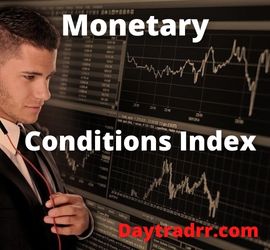What Is the Monetary Conditions Index (MCI)?
 The monetary conditions index (MCI) was created in the early 1990s to capture two significant monetary transmissions. It combines changes in the short-term interest rate and the effective exchange rate into a single variable or index to gauge the relative ease or tightness of monetary conditions. The metric assists central banks in developing monetary policy. As a result, the monetary conditions index (MCI) has become a worldwide standard.
The monetary conditions index (MCI) was created in the early 1990s to capture two significant monetary transmissions. It combines changes in the short-term interest rate and the effective exchange rate into a single variable or index to gauge the relative ease or tightness of monetary conditions. The metric assists central banks in developing monetary policy. As a result, the monetary conditions index (MCI) has become a worldwide standard.
The Bank of Canada created the monetary conditions index in the early 1990s. The purpose was to investigate the linkages between Canadian interest rates, the relative trade exchange rate of Canadian currency, and the Canadian economy as a whole. On a monthly basis, the bank releases data for both the MCI and its components.
Calculating the Monetary Conditions Index (MCI)
Computing the monetary conditions index (MCI) is straightforward. A country’s central bank will normally choose a base period. Next, they plot the weighted average of interest rate and exchange rate changes against the actual values of those variables. This computation, in theory, allows central banks to track the impact of short-term monetary policy. It combines changes in interest rates set by central banks with changes in exchange prices controlled by the open foreign exchange market. Each country calculates its MCI slightly differently. However, the purpose remains the same. It is to evaluate the relationship between changes in interest rates and exchange rates from a base period.
Canada, for example, has changed how it calculates its MCI a few times. From 1987 to 1999, the MCI calculation used the change in the 90-day commercial paper rate, then added a portion of the movement in the exchange rate of the Canadian dollar (CAD). This exchange rate measures the CAD to the C-6 exchange rate. The C-6 averaged the currencies of six of Canada’s major trading partners: the United States, Europe, Japan, the United Kingdom, Switzerland, and Sweden. The Canadian-dollar effective exchange rate index (CERI) replaced the C-6 index in 2006 and was retired in 2018 for a new method. In 2018, the MCI calculation moved to the nominal Canadian effective exchange rate (CEER). This is a weighted average of bilateral exchange rates for the CAD against the currencies of Canada’s most prominent trading partners. Currently, CEER includes 17 currencies. (Source: investopedia.com)
MCI vs Taylor Interest Rate Rule
The Taylor rule is an equation proposed by John Taylor in a 1993 study. It prescribes a value for the federal funds rate, the short-term interest rate targeted by the Federal Open Market Committee (FOMC). It is based on inflation and economic slack measures such as the production gap or unemployment gap. The Taylor interest rate suggests that the central bank should set the short-term interest rate on the current economic situation with regard to inflation and the business cycle. Specifically, the federal funds rate should be adjusted when inflation deviates from the Fed’s inflation target. Or, it should be adjusted when output deviates from the Fed’s estimate of potential output. Typical formulations of the rule assume that the level of the inflation is expected to prevail in the long run.
Taylor rules are simple monetary policy guidelines. They specify how a central bank’s interest rate policy instrument should be adjusted in a systematic manner. Typically these adjustments are in response to changes in inflation and macroeconomic activity. Nevertheless, they provide a valuable framework for analyzing historical policy. Further, they assist in evaluating alternative tactics a central bank can utilize as the foundation for interest rate choices.
There are a number of variants of the Taylor rule, but in all of them one important determinant of the policy prescription given by the rule is the level of the inflation-adjusted federal funds rate that is expected to prevail in the long run. This rate is sometimes thought of as the equilibrium or “natural” rate of interest in the sense that it is what the economy’s benchmark short-term interest rate would be absent inflation and transient influences. For the sake of this discussion, we will refer to the rate as the natural interest rate. (Source: clevelandfed.org)
Monetary Conditions Index (MCI) – International Use
The popularity of the MCI and its very straightforward calculation has grown. Many other central banks now use it as a reference point and a tool to assist guide monetary policy. The MCI is used not only by central banks around the world, but also by organizations such as the International Monetary Fund (IMF) and the Organisation for Economic Co-operation and Development (OECD) for a range of economies. While the index’s components remain basically the same, different organizations will assign different weights to the equation’s elements. Using different weights will realistically reflect real-world situations in a given economy. External influences may need changes to the weighting of variables in the MCI calculation in some circumstances. Central banks, on the other hand, will almost always utilize constant parameters. In short, the MCI provides a perspective of an economy’s relative ease or tightness across time.
Numerous central banks, governmental organizations, and businesses now calculate an MCI as an indicator of the stance of monetary policy. Two central banks, those for Canada and New Zealand, use their MCIs as operational targets. An MCI is a weighted average of changes in an interest rate and an exchange rate relative to their values in a base period. The weights on the interest rate and exchange rate reflect the estimated relative effects of those variables on aggregate demand over some period, often approximately two years. MCIs are currently used as indicators of monetary conditions and as operational short-run targets for monetary policy. An MCI assumes an underlying model relating economic activity and inflation to the variables in the MCI, with the weights in the MCI reflecting the effects of the interest rate and exchange rate on aggregate demand. (Source: bis.org)
Up Next: Defeasing Loans and Bonds
 Defeasing outstanding loans or bonds is simply substituting collateral that is sufficient to meet all payments of principal and interest on the outstanding securities as they come due.
Defeasing outstanding loans or bonds is simply substituting collateral that is sufficient to meet all payments of principal and interest on the outstanding securities as they come due.
In a contract, a defeasance clause is a provision that voids a bond or loan on a balance sheet when the borrower sets aside enough cash or bonds to service the debt. Because the borrower sets aside funds to pay off the bonds, the outstanding debt and cash balance each other out. As a result, there is no longer a need to record the original debt on the balance sheet.
In a mortgage contract, a defeasance clause indicates that the property’s title or ownership will be transferred to the borrower (mortgagor) after the lender’s payment conditions are met. However, real estate rules and terminology differ from state to state based on the type of mortgage theory used. As a result, not all mortgage agreements will have a defeasance clause. A defeasance clause transfers title upon debt fulfillment. Therefore, these clauses are normally used in jurisdictions where the bank retains ownership of the residence until the mortgage is paid off.




